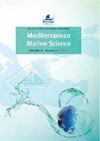突尼斯加布特斯湾石斑鱼延绳钓渔业中作为副渔获物捕获的板鳃类的脆弱性
IF 2.3
3区 环境科学与生态学
Q1 MARINE & FRESHWATER BIOLOGY
引用次数: 1
摘要
本研究的目的是量化石斑鱼底栖延绳钓渔业对加布里斯湾石斑鱼科的影响,以支持未来对最脆弱物种的保护行动。对2016年和2017年石斑鱼捕捞季节进行的162套海底延绳钓数据进行了分析。捕获的石斑鱼至少17种,约占总捕获量的50%,超过了目标捕获量(44.15%)。在162个群落中,有139个群落(85.80%)存在弹性枝,而每个群落的出现频率因物种而异。所有鱼种的单位渔获量合计为每1,000鱼钩/小时3.07个标本。鲨鱼和蝙蝠类对板鳃纲总捕获量的贡献相同,分别占51.84%和48.16%。鼠尾鲨(Mustelus Mustelus)、细尾鲨(Carcharhinus plumbeus)和角鲨(Squalus spp.)是最丰富的物种,占总捕获量的45.65%,其余鲨鱼种类很少被捕获(6.19%)。蝙蝠目以小丘绿骨舌蝇(Glaucostegus cemiculus)占捕获总数的19.07%,其次为大腹舌蝇(Dasyatis)(8.91%)、克拉瓦塔拉贾(Raja clavata)(7.1%)和格拉塔带蝇(Taeniura grabata)(4.59%)。因商业价值低和/或体型小而被丢弃的板鳃鱼占总捕获量的11.34%。生产力和敏感性分析结果表明,研究区沿海石斑鱼胎生物种极易受到延绳钓渔业活动的影响,应谨慎管理,以减少过度捕捞的可能性。本文章由计算机程序翻译,如有差异,请以英文原文为准。
Vulnerability of elasmobranchs caught as bycatch in the grouper longline fishery in the Gulf of Gabès, Tunisia
The present study aims to quantify the effect of the grouper demersal longline fishery to elasmobranchs in the Gulf of Gabès to support future conservation actions for the most vulnerable species. Data from 162 demersal longline sets carried out during the grouper fishing seasons in 2016 and 2017 were analyzed. At least 17 elasmobranch species were caught, representing about 50% of the total catch in number which exceeded the target catch of groupers Epinephelus spp. (44.15%). Elasmobranchs were present in 139 (85.80%) out of the 162 examined sets, while the frequency of occurrence per set varied greatly depending on the species. The nominal Catches Per Unit Effort of all species combined was 3.07 specimens per 1,000 hooks/hour of fishing. Sharks and batoids contributed equally to the total elasmobranch catch, comprising 51.84% and 48.16% in terms of number, respectively. Mustelus mustelus, Carcharhinus plumbeus and Squalus spp. were the most abundant species, representing 45.65% of the total elasmobranch catch, whereas the remaining shark species were rarely caught (6.19%). Batoids were dominated by Glaucostegus cemiculus, which represented 19.07% of the total elasmobranch catch in number, followed by Dasyatis spp. (8.91%), Raja clavata (7.1%) and Taeniura grabata (4.59%). The elasmobranchs discarded due to their low commercial value and/or small size represented 11.34% of the total catch in number. According to the results of the Productivity and Susceptibility Analysis, the coastal viviparous elasmobranch species in the study area are highly vulnerable to the grouper longline fishery activity and should be carefully managed to reduce the likelihood of overfishing.
求助全文
通过发布文献求助,成功后即可免费获取论文全文。
去求助
来源期刊

Mediterranean Marine Science
MARINE & FRESHWATER BIOLOGY-
CiteScore
5.20
自引率
17.90%
发文量
34
审稿时长
>12 weeks
期刊介绍:
The journal Mediterranean Marine Science (MMS), published by the Hellenic Centre for Marine Research (HCMR), issues three volumes annually. The journal welcomes original research articles, short communications, New Mediterranean Biodiversity records, extended reviews, comments, and Theme sections in all fields of Oceanography, Marine Biology, Marine Conservation, Fisheries and Aquaculture in the Mediterranean area and the adjacent regions. All content is peer reviewed.
 求助内容:
求助内容: 应助结果提醒方式:
应助结果提醒方式:


